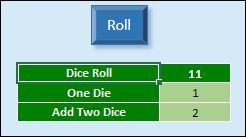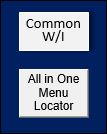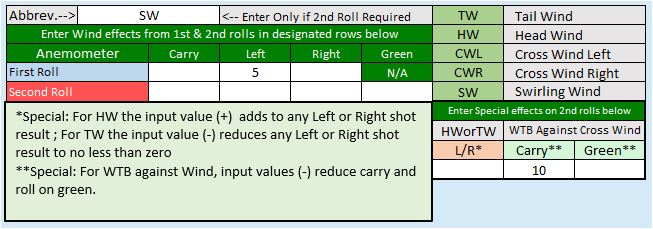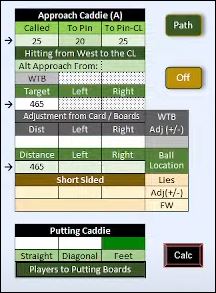Over the weekend, IDJESTER, made his third “practice” video, in which he plays holes 6 through 9 at Magnolia by himself. Once again, he’s asked for my feedback, so that he and his viewers can learn the game, the utility, and improve their play.
He also makes a number of suggestions for me to consider in future updates to the GC. He and I will discuss these when we get together for a second “Live GC 4.1.1 Tutorial” this Wednesday at 7pm EDT. (Actually, I hope to have GC 4.1.2 ready for us to use that night.) Everyone is welcome to join us on his YouTube channel.
IDJ’s understanding of how to use the Game Caddie is pretty good at this point. Most of the feedback I provide here pertains to the finer aspects of using it and the APBA Master Game rules, themselves. For the benefit of those who may not have seen his earlier videos or my previous posts, I will repeat a couple of comments I’ve made before:
- After you load a hole, the GC automatically takes you to the Conditions tab and does the 1st Wind roll for you to make things faster. It is the two-digit APBA number that appears across from Dice Roll. If you prefer to roll again or use your own dice, you certainly can. In any case, you still need to apply the dice roll result (if any).

- The “W” column on APBA Golf cards is used for any shot or work-the-ball (WTB) roll for the Driver through 4I. The “I” column is used for 5I through SW. (The clubs carry chart on the Caddie tab has a bold line between 4I and 5I to help you remember the distinction.) The “A” column is used for approach shots between 100 and 5 yards out. The “P” column is used for all putts and when you decide to chip using the putter from one or two FW squares off the green.
- The Average W/I “bonus” only applies to W/I Shot rolls (not WTB rolls).
- If you want, you can type an initial putt distance into the Putt Dist. box in the Notes on the Caddie tab. You do not need to re-use the Calc button. In fact, the Calc button produces a random result each time it’s used (based on APBA dice-rolling rules for distance away). Therefore, if you do re-use the Calc button, you are likely to get a different result.
- Balls that are less than one full square into the rough relative to the centerline (CL) are considered to be in the Intermediate Rough (IR). According to the APBA Master Game rules, balls that land or roll in the IR roll the full FW amount. Some “homebrew” players prefer to cut the roll in half. The GC doesn’t care.
- When hitting from the IR, use the FW column unless otherwise instructed (e.g., when a 1st Lie roll of 61 – 64 for IR says, “Use RR Column”). If using the All in One Menu, the GC will make all Lie rolls for you. A pop-up message will tell you if a different Lie column is being used. The All in One Menu automatically uses the new Lie column without you needing to do anything different.
- If you are unsure of an APBA Master Game rule or don’t know how the GC may apply it, you can consult the Caddie Notes tab. It doesn’t cover as much as the APBA rulebook, but it’s probably quicker when you just need a bit of clarification.
- The pop-up Common W/I chart that automatically opens when you use the All in One Menu displays the carry distances for your specific type of lie (Tee/FW, Rough, or Sand). The yellow Common W/I chart where you pick your three clubs only shows carry distances for Tee/FW lies. If you want to disable/re-enable the pop-up chart, click the W/I button that appears at the lower right of the Caddie tab screen.

- In addition to doing all Lie rolls for you, the All in One Menu does all 2nd rolls for wind. You do not need to go to the Conditions tab. Instead, look at the Wind tool on the Caddie tab. If there is no wind on the 2nd roll, the Wind boxes will be blank. Otherwise, they will show you what effect the wind had on the shot.
- According to APBA Master Game rules, you are not supposed to “aim” second shots on par 5’s unless you are going for the green (or the hole notes allow it). Many APBA players disregard this rule or modify it in some way. I just mention it for the purpose of clarity.
- Speaking of hole notes, before playing any hole it’s a good idea to check them. They are called Course Notes on the APBA course boards. The GC refers to them as Hole Notes, and they appear in abbreviated form at the upper right of the Caddie tab screen. Some GC Hole Notes have a “TC” designation. Those are the adjustments that Dr. Tom Cline, APBA Master Game designer, recommends and are used in the GC with his permission. Use the Course Adjustments tool to apply any Hole Note effects to W/I shots.

- According to Master Game rules, dogleg effects are ignored for second (or subsequent) shots unless you are blocked by trees. If you do not have tree clearance for the club you want to use, you can: (1) play safe back to the CL, (2) select a different club that does have clearance, or (3) hit around trees. If you choose option #3, you should click the Applies? box in the Dogleg tool to turn it back on (i.e., change N to Y).
- If you need to manually enter wind effects (e.g., for a course that has its own wind charts), always use the Anemometer on the Conditions tab. You can type in or edit any of the white boxes. Never use the Course Adjustments tool for this purpose, as certain wind effects (e.g., 50% reduction on Approach shots from 50 – 75 yards out) are only applied to information in the Anemometer.

- When using the Approach Caddie, you use the “Called” distance to determine which Approach board to use, except when the “To Pin” distance is 20 yards or less. In that case, the APBA Master Game rules permit you to use the distance to the pin (i.e., the “To Pin” distance).

Again, the bulleted items in this post are about the finer points of using the Game Caddie and APBA Master Game rules. I offer these tips in the spirit of helping everyone get the most out of the game and this tool. To check your understanding of the GC, I invite you to take this anonymous self-assessment. Please post any questions or comments blow, so that others may also learn.